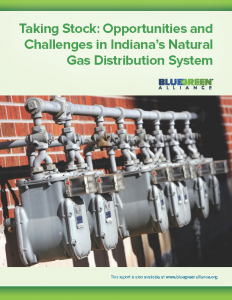Taking Stock: Opportunities and Challenges in Indiana’s Natural Gas Distribution System
Working with frontline gas sector workers, environmental groups, industry, and additional community stakeholders, the BlueGreen Alliance identified challenges and opportunities facing the network of natural gas distribution pipelines in Indiana.
Indiana’s natural gas distribution pipeline system is a network of more than 40,000 miles of pipe that supplies homes, businesses, and communities with energy. In 2013, many of these pipes were reaching the end of their service life. Approximately 30 percent—or more than 12,000 miles—of the state’s existing distribution pipeline was installed in 1969 or earlier, and will be more than 50 years old if still in use in 2020.1 These percentages appear in line with the age of distribution pipes nationwide.
Residents of Indiana have felt firsthand the impacts of the state’s aging natural gas distribution pipelines. For example, in November of 2002, leaks in a natural gas pipe caused explosions that destroyed three homes and injured at least four people in Lafayette. Years later, in May of 2011, a natural gas pipeline near Rockville exploded and caught fire. While no injuries were reported, 49 homes were evacuated within a one-mile area of the explosion. After the fire, the Pipeline and Hazardous Materials Safety Administration (PHMSA) indicated the possibility of external corrosion in a Corrective Action Order to the pipeline company.
As part of a state-focused education and outreach project conducted throughout 2014 and 2015, the BlueGreen Alliance convened stakeholder meetings and public forums to build on existing knowledge and engage frontline gas sector workers, environmental groups, industry, and additional community stakeholders to identify challenges and opportunities facing the network of natural gas distribution pipelines in the state of Indiana.
